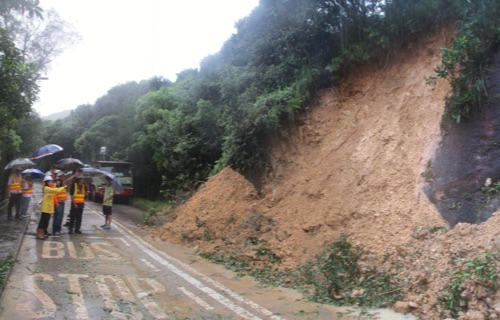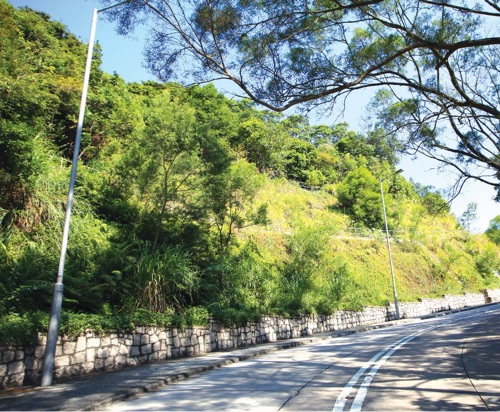在山多平地少的香港,加強維護斜坡安全對於減低山泥傾瀉的風險起着關鍵作用。天災無情,但人間有愛,只要在人力所及的範圍內做好工作,就可以盡量避免災難事件重演。 With Hong Kong's mountainous terrain, enhancing slope safety is the key to minimising the occurrence of landslides. While the elements may be relentless, with the utmost effort, it is still possible to avoid disasters from happening again.
自成立以來,土力工程處逐步建立一套全面的斜坡安全管理系統,從不同層面降低山泥傾瀉的潛在風險。然而,山泥傾瀉風險會隨著人口增長、斜坡老化和日趨頻繁的極端天氣而上升,土力工程處需要不斷改進其斜坡安全管理系統,希望令身處山坡附近的居民可以安枕無憂。張偉文處長表示:「我們主要從三方面去控制山泥傾瀉風險。第一,我們會管制新發展項目和審核岩土工程設計,以控制新發展所帶來的風險。第二,我們會透過鞏固和維修政府斜坡、推動私人斜坡維修,以及在天然山坡採取風險緩措施,以降低現有發展所面對的山泥傾瀉風險。第三,香港山多,山泥傾瀉風險永遠不可能是『零』,但我們會盡力減低所造成的影響,例如發布山泥傾瀉警告、提供山泥傾瀉緊急服務,以及教育公眾採取預防措施等。」 Ever since its establishment, the GEO has progressively developed a comprehensive slope safety system to tackle the different aspects of potential landslide risks. However, as population grows, slope degradation and increasingly frequent extreme weather events can heighten the risk of landslides, the GEO continues to improve the slope safety system to help ensure the safety of residents who live near slopes. According to Dr. Raymond Cheung, Head of the GEO, “ We control landslide risks mainly from three aspects. Firstly, we regulate new development projects and review the design of geotechnical works to control their landslide risks. Secondly, we upgrade and maintain government slopes, promote private slope maintenance and implement risk mitigation measures on natural hillsides, so as to minimize the landslide risks of existing development. Thirdly, although the risk of landslides for a mountainous place like Hong Kong can never be reduced to ‘ zero ’ , we try our best to lessen the impact. For instance, we issue landslip warnings, provide landslide emergency services and raise public awareness of precautionary measures. ”

自1977年成立以來,土力工程處一直致力減低香港的山泥傾瀉風險,並推行「防止山泥傾瀉計劃」,鞏固有潛在危險的人造斜坡。因應氣候變化和香港的持續發展,土力工程處的工作方針這些年來亦與時並進,務求與無情的天災競賽。 Since its establishment in 1977, the GEO has been striving to reduce the risk of landslides in Hong Kong. The Landslip Preventive Measures Programme ( LPMP ) was put in place to deal with man-made slopes with potential risks. In response to climate change and the continuous development of Hong Kong, the GEO has also adjusted its strategies over the years in a race against the relentless elements to prevent disasters.
維護斜坡安全的工作並非一蹴而就,而是需要專業人員多年來辛勤工作累積下來,才會漸漸取得成果。雖然香港在二十一世紀仍然不時出現大大小小的山泥傾瀉事件,但自從政府開始有系統地處理斜坡安全問題之後,由1980年代開始,山泥傾瀉的災情以至人命傷亡情況都較之前大為減輕。 The work of maintaining slope safety is a long-term effort. It takes years of hard work by professionals to achieve noteworthy results. Entering the 21st century, even though landslides of various scales still occur occasionally in Hong Kong, the resulting damage and casualties have been far less severe, continuing a trend since the 1980s, when the government began to take a systematic approach to addressing the issue of slope safety.
一九八零年代
The 1980s
1982年夏天,香港各處的寮屋區接連發生不同規模的山泥傾瀉事故。往後數年,同類的不幸事件繼續在各處發生,部分寮屋區的居民更屢次受災。 In the summer of 1982, landslides of various degrees occurred one after another in the squatter areas of the territory. In the following years, similar disasters continued to happen in different places. At some squatter areas, residents suffered landslides repeatedly.
這段期間,因寮屋區山泥傾瀉而死亡的人數超過30人。隨着政府於八十年代初開始為全港的寮屋登記,並透過非發展性清拆計劃有序地清拆寮屋和安置居民,寮屋區的山泥傾瀉問題亦漸露曙光。 During this period, over 30 people were killed due to landslides in squatter areas. As the government started to register squatter structures in the early 1980s, as well as to clear squatter huts and rehouse residents through the Non-Development Clearance Programme, glimmers of hope emerged for addressing the landslide issue in squatter areas.
一九九零年代
The 1990s
自土力工程處成立以來,轄下的「防止山泥傾瀉計劃」按風險為本的原則處理了大批不合標準並靠近樓宇和繁忙道路的斜坡。經過他們多年的努力,在九十年代初期,沒有發生像七八十年代的嚴重山泥傾瀉災難。然而,九十年代中後期發生的數宗致命山泥傾瀉事件,再次提醒工程人員及市民仍然要面對山泥傾瀉的風險,以及維護斜坡安全對保障生命和財產的重要性。
After its establishment, the GEO upgraded a large number of substandard slopes adjacent to residential buildings and major roads in accordance with a risk-based priority ranking system under the LPMP. In the early 1990s, years of untiring effort resulted in a time of relative safety, with severe landslide disasters like those in the 1970s and 80s seemingly a thing of the past. However, several fatal incidents took place in the mid to late 1990s, serving as reminders to engineers and the public that Hong Kong was still prone to landslides, and that it was crucial to maintain slope safety to protect lives and properties.
1994年7月23日,天文台發出山泥傾瀉警告,大雨持續48小時未有休止。堅尼地城觀龍樓D座對下的部分砌石牆及斜坡突然塌下,導致5名途人遇難。當時率先到達現場的消防車,剛巧由曾經參與「六一八」事件救援工作的胡強擔任主管。他憶述拯救的難度:「現場漆黑一片,我們只聽到泥石下傷者求救的聲音。其中一位生還者不斷請求我們先救她的女兒,但因為位置的關係,我們得先移開山泥救出那位母親,然後再徒手挖掘半小時左右,才可以把她的女兒救出。」
On July 23, 1994, the Hong Kong Observatory issued a landslip warning amid almost 48 hours of torrential rain. At the Kwun Lung Lau building in Kennedy Town, part of the masonry wall and a slope below Block D suddenly collapsed, killing five people. The first fire engine on the scene happened to be under the charge of Wu Keung, who had participated in the rescue operation of the 6.18 Landslide Disaster. He recalled how difficult it was to rescue the survivors, “ The site was in complete darkness and we could only hear survivors crying for help under the debris. One of them kept asking us to help her daughter first. However, we had to save her first as she was more accessible. We manually removed the debris to get her out and kept digging further with our hands for another 30 minutes or so before we could reach her daughter.”
觀龍樓事件後翌年,政府決定增撥資源,落實「五年加速防止山泥傾瀉計劃」。此外,土力工程處亦成立由國際岩土專家組成的斜坡安全技術檢討委員會,審視及檢討土力工程處在斜坡安全的工作及成效。處方亦對山泥傾瀉的發生進行系統性研究,從而提出改善斜坡設計及建造的建議。此外,土力工程處由九十年代開始使用泥釘加固斜坡,使斜坡安全的情況進一步改善。 In the year after the Kwun Lung Lau incident, the government launched the 5-year Accelerated Landslip Preventive Measures Project to allocate more resources to tackle the risk of landslides. The GEO also set up the Slope Safety Technical Review Board ( SSTRB ) comprising renowned geotechnical experts from across the globe to examine and review GEO's work and effectiveness in slope safety management. The GEO also conducted systematic studies of landslides to come up with recommendations for improving slope design and construction practice. Apart from this, the GEO started applying soil nails to reinforce slopes in the 1990s, thus further enhancing slope safety in Hong Kong.
二十一世紀
The 21st Century
在香港,天然山坡山泥傾瀉時有發生,但由於早年仍有很多不合標準的人造斜坡尚未鞏固,而且這些人造斜坡大多靠近住宅樓宇和繁忙道路,風險相對較高,所以政府的「防止山泥傾瀉計劃」自1977年推行以來,一直集中資源處理人造斜坡。 While natural hillside landslides do occur in Hong Kong from time to time, the government had been focusing its resources on man-made slopes since the LPMP was implemented in 1977. This was because a considerable number of substandard slopes had not yet been stabilized in those early days and were of relatively higher risk due to their proximity to residential buildings and busy roads.
經過30多年的努力,人造斜坡的整體山泥傾瀉風險已經大幅減低。另一方面,在都市化影響下,越來越多的發展項目靠近陡峭的天然山坡。因此,天然山坡的山泥傾瀉風險與日俱增,其風險水平與人造斜坡相若。因此,土力工程處在2007年着手籌劃「長遠防治山泥傾瀉計劃」,把工作擴展至天然山坡的山泥傾瀉風險緩減工程,以合理可行的方法,將山泥傾瀉的風險盡量減低。 After 30 years of hard work, the overall risk of landslides for man-made slopes was significantly mitigated. On the other hand, the landslide risk from natural hillsides was now comparable to the risk from man-made slopes, due to the encroachment of more urban developments on steep natural hillsides. In light of this, in 2007, the GEO started working on the Landslip Prevention and Mitigation Programme(LPMitP) to extend its work to the mitigation of natural terrain landslide risk, aiming to further reduce the risk of landslides in Hong Kong by practicable measures.
2005年及2008年的兩場暴雨,令天然山坡山泥傾瀉的問題更備受關注。在2005年8月16至22日,土力工程處共接獲229宗山泥傾瀉報告,包括在8月20日發生接連多宗與天然山坡有關的山泥傾瀉。
2008年6月7日,大嶼山4小時內錄得的最高雨量達384毫米,單在大嶼山就引發了2,400多宗天然山坡山泥傾瀉。連接市區與機場的北大嶼山公路有200米路段因天然山坡山泥傾瀉而被泥石及洪水淹蓋,截斷了通往機場的重要運輸通道長達16小時。
同日早上,大澳共有13宗山泥傾瀉報告,塌下的山泥體積由25立方米至2,000立方米不等,堵塞了大澳通往外間的道路,加上流動及固網電訊設備均出現故障、食水供應中斷,數以千計居民的生活大受影響。
The issue of natural hillside landslides was brought to public attention by the rainstorms in 2005 and 2008. A total of 229 landslides resulting from the rainstorm from August 16 to 22, 2005, was reported, including a series of natural hillside failures in different parts of the territory on August 20.
On June 7, 2008, a 4-hour rolling rainfall of 384 mm was recorded at Lantau Island, triggering more than 2,400 natural terrain landslides in the area. One landslide blocked a 200-meter section of the North Lantau Highway with soil debris and muddy water, causing the closure of this artery that connected the city to the Hong Kong International Airport for as long as 16 hours.
In the same morning, 13 landslides were reported in the Tai O area, with debris volume ranging from 25 to 2,000 cubic meters, blocking the roads to Tai O. The damages to mobile and fixed-line telephone networks and the water mains added to the nightmare of thousands of residents.

為了全面地處理好天然山坡和人造斜坡的山泥傾瀉風險,土力工程處於2010年開展「長遠防治山泥傾瀉計劃」。由於天然山坡的覆蓋範圍比人造斜坡大得多,在天然山坡進行大規模的斜坡鞏固工程,勞民傷財之餘,對自然生態亦有嚴重影響。如果採取風險緩減措施,例如透過山坡下的泥石壩和柔性防護網阻擋塌下的泥石湧入民居或道路而造成傷亡,除了成本較低之外,還可以避免對環境造成不必要的影響。
To manage the landslide risks of both natural terrain and man-made slopes in a more holistic manner, the GEO launched the LPMitP in 2010. As natural hillsides cover a much larger area than man-made slopes, it would have been both costly and environmentally damaging to stabilize natural hillsides on an extensive scale.
Using risk mitigation measures such as rigid barriers or flexible barriers to prevent debris from reaching houses or roads and resulting in casualties not only comes at a lower cost, but also avoids undue impact to the environment.
截至2022年9月底,土力工程處已鞏固了約6,450幅政府人造斜坡,為超過400幅天然山坡完成風險緩減工程,並為約6,350幅私人人造斜坡完成了安全篩選研究。 As of the end of September 2022, some 6,450 government man-made slopes have been stabilized, with risk mitigation measures implemented for more than 400 vulnerable natural hillsides and safety screening studies completed for about 6,350 private man-made slopes.
自土力工程處成立後,山泥傾瀉導致的死亡人數已大幅減少,香港自2008年起已經再沒有出現奪命的嚴重山泥傾瀉事故。時至今日,「山泥傾瀉」這標題只是偶然在媒體中出現,但這並不表示市民可以因而掉以輕心。 Since the establishment of the GEO, fatalities caused by landslides have dropped substantially and Hong Kong has not seen a fatal landslide since 2008. Nowadays, the topic “ landslide ” only appears occasionally in the media. However, this does not mean that the public can overlook the risk of landslides.
近年,全球暖化令極端天氣加劇的問題迫在眉睫。以往天文台總部每小時雨量破紀錄的情況數十年才發生一次,但最近十數年卻屢破紀錄。為了應對極端天氣帶來的挑戰,並抓緊創新科技所帶來的機遇,土力工程處從預防、應變和教育等三方面做好準備: In recent years, extreme weather fueled by global warming has become an ever more urgent issue. The hourly rainfall record as reported by the Hong Kong Observatory Headquarters used to take decades to break. In the last decade or so, however, that record has already been rewritten several times. To combat the challenges of extreme weather and to take advantage of the opportunities made possible by innovation and technology( I&T ), the GEO is taking a three-pronged approach, namely prevention, preparedness and education:

土力工程師在山泥傾瀉現場視察 Geotechnical engineers inspect a landslide site
當天文台發出山泥傾瀉警告或八號或以上熱帶氣旋警告信號時,土力工程處的緊急控制中心便會啓動,由一共十三隊以土力工程師及技術主任所組成的專責隊伍輪班當值。接獲山泥傾瀉報告後,他們會無懼風雨到現場視察,協助各政府部門進行緊急工程,務求盡快恢復受影響的公共服務。 When a landslip warning or typhoon signal number 8 or above has been issued by the Hong Kong Observatory, the GEO will activate its Emergency Control Centre, which is manned by one of the 13 dedicated teams of geotechnical engineers and technical officers on a rotational basis. If a landslide report is received, geotechnical engineers will brave the wind and rain to reach the scene to assist government departments in conducting emergency works so that public services can be restored as soon as possible.
土力工程處近年亦建立了「聯合運作平台」,提升各政府部門實時共享緊急資訊的能力,以協助政府評估災情及調配緊急服務,為市民提供適時協助。 In recent years, the GEO has also developed the Common Operation Picture, which is a platform for real-time sharing of emergency information to facilitate the government's assessment of the situation and enhance the coordination of government departments' emergency responses to provide timely assistance to members of the public.


在斜坡鞏固工程中加入綠化元素 Greening measures in slope upgrading works